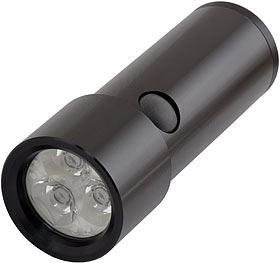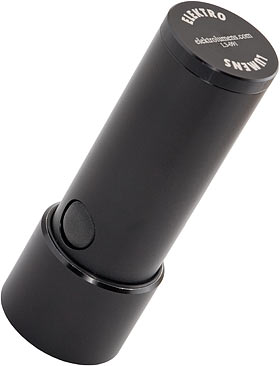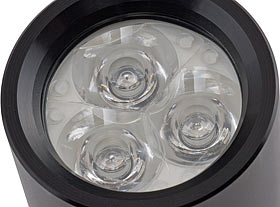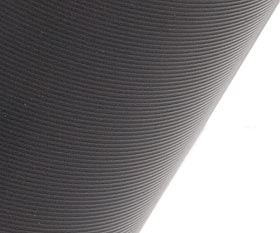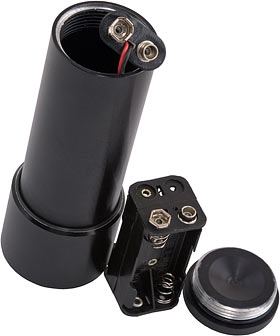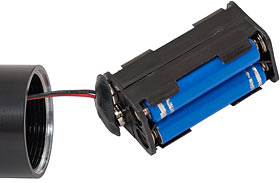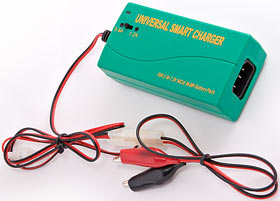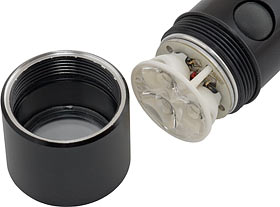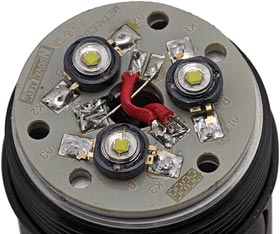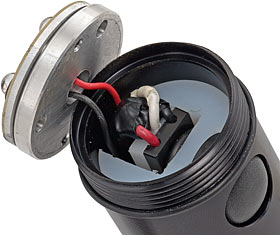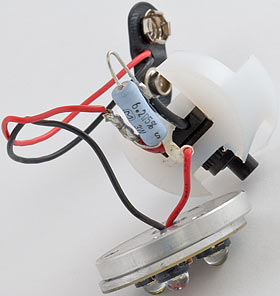
Elektro Lumens Little Friend
Review date: 31 July 2006 Last modified 03-Dec-2011.
This flashlight...
...is actually, seriously, called the Little Friend.
No, not as in Calvin, or Piglet. As in Al Pacino's M203.
This is the sort of naming decision you can make when you're in charge of a little company like Elektro Lumens. You may not be terribly likely to end up as a globe-spanning business colossus, but you can make whatever products you want without worrying about some marketing dink's babble about "branding" and price brackets, and you can call 'em what you like.
And the name's fair enough, actually.
This stubby little flashlight looks as if it should run from a single D cell (though it doesn't). It's a hair under 12 centimetres long (4.7 inches), under 4.4 centimetres (1.7 inches) wide at the lamp end, and it weighs a little less than 250 grams with batteries in it (8.7 ounces). So you can put it in most front pants pockets, rather uncomfortably. More realistically, it easily qualifies as a handbag or jacket pocket flashlight. It really isn't very big at all.
But it costs $US110.
Here's the reason for that. This flashlight's lamp uses three of Lumileds' Luxeon 3 high powered LEDs, connected in parallel.
One would have been sufficient.
The Luxeon 3 runs at 30 times the power, and rather more than 30 times the brightness, of a super-bright white 5mm LED. A lot of big LED flashlights only need one of them.
That wasn't enough for Elektro Lumens; they originally wanted to use the newer K2 versions, which can handle a bit more power and run at a higher temperature without dying. That second part is a big deal because LEDs, unlike incandescent bulbs, don't like running hot. So "super LEDs" with power ratings of a watt or more have to be attached to a heat sink if you want to use them at (or beyond...) their rated power, or they'll burn up in no time.
K2s wouldn't fit under the neat-o three-lens optic, though, so plain old Luxeon 3s it is here, with a disc of aluminium behind them to keep them cool.
The only way to get lots of light out of 5mm LEDs was to use a lot of them, resulting in lights like the ones I reviewed here and here. A single Luxeon 3, in contrast, is quite bright enough for any normal household flashlight. Use three of 'em, and you get a lot more light than most people even want, most of the time.
The Little Friend has a solution for this problem, though. It's got a two-setting power switch.
Click the rubber-covered button on the side of the Friend once, and you get low brightness mode. Click again and it turns off; click a third time and you get high brightness. Very high brightness.
The Little Friend's main beam has an angle of around 20 degrees, smoothly shading into a roughly 10 degree really bright portion in the middle, and in the low brightness mode from fresh batteries (which I'll get to in a moment) that middle portion averages around 730 lux at one metre, with peaks of nearly 850 lux.
That's already quite bright, for a light of this size. The minimum level of illumination necessary for most people to see colour is around 1 lux (that's also what you get from bright full moonlight); the minimum level that's useful for seeing at all (with your eyes accustomed to the dark) is about 0.1 lux. This light, in low brightness mode, will illuminate a roughly nine metre circle to 1 lux at a distance of 27 metres, and a 30 metre circle to 0.1 lux at a distance of 85 metres.
In high brightness mode, the average light output (according to my never-agrees-with-any-flashlight-manufacturer's-specs meter) is floating around the 2400 lux mark, and the peak's up around 2900.
That's a lot more light than you expect to see coming out of a thing this size. It gives a 1 lux range of about 49 metres and a 0.1 lux range of about 154 metres, with illumination circles of around 17 and 54 metres, respectively.
The Little Friend's switch, by the way, turns on when you release it after clicking it, and off as soon as you press it down while the light is on. This means you can't half-press the switch for a "momentary" mode to make the light shine only while you're holding the button. That'd be a handy feature for a light like this, since otherwise any time you use it in small doses you're likely to end up cycling through whichever brightness level you don't want quite often. But it's hardly a crippling problem.
(You can partially press the button to turn the light off, when it's on. This is not tremendously useful.)
The Little Friend, by the way, has the same basic design as Elektro Lumens' earlier "Blaster" lights, two of which I've reviewed here and here. This is a good thing, because those lights look and feel great.
These lights are all made from aluminium, and use lensed LEDs, not reflectors. That means they don't need a big lamp assembly, and instead share a family look - one battery-tube cylinder with another slightly fatter lamp cylinder stuck to its end. They also...
...have countless little grip ridges around the barrel. The ridges give these lights a sort of fine-corduroy texture that's easy to hold on to in all but the most extreme conditions.
Power
So what's it all run on?
AAA cells. Four AAA rechargeables, to be exact, which you install in a little holder that's a bit smaller than a D cell.
The Little Friend doesn't come with batteries, but high capacity NiMH AAAs are a commodity item these days.
The battery holder has a standard 9V-battery-type snap connector on the end. Battery snaps are very cheap and somewhat nasty, but they're electrically and physically solid, and easy to interface with other devices. You can get a battery-snap-to-bare-wires dirt cheap from any electronics store, and with that and another connector - or alligator clips - you can easily and reasonably safely connect the Little Friend pack to any charger.
The Little Friend doesn't come with a charger, either, but you can buy this one from Elektro Lumens for $US33. It's a simple plug-and-go smart charger for two- to six-cell (2.4 to 7.2 volt) packs, so you can use it for all sorts of other packs if you like. It comes with a Tamiya-type plug, so you can plug it straight into many standard six-cell R/C car battery packs, and there's also an alligator clip adapter which lets you connect it to random other packs, including the Little Friend's.
The charger comes with an American mains lead that's no use to me here in Australia, but the mains lead plugs into a standard IEC socket and the charger's world-compatible as far as AC voltage and frequency goes, so it's easy to use it anywhere.
The charger automatically starts when you connect it to a battery pack and stops when the pack's full; the only control on it is a slider switch to select 0.6 or 1.2 amp charge current. For NiMH AAA recharging, you should use the lower setting, unless you're in a hurry and just want to throw some charge into flat cells without filling them right up.
If you've already got a charger that'll accept four NiMH AAAs, you don't need to buy this one - but if your current charger is the usual "tray" kind that charges cells individually, you'll need to pop the AAAs out of the Little Friend's holder to charge them.
That could get old pretty fast, because as you've probably figured out already, the Little Friend's combination of little tiny AAA cells and big beefy lamp means it doesn't have a whole lot of battery life. Elektro Lumens quote 20 to 30 minutes of burn time at high brightness, or about two hours on the low setting. This, of course, depends on the capacity of the batteries you use, but there are several other annoying factors.
Because the Little Friend provides those convenient separate wires between its battery pack and switch, I tested its current draw with my clamp meter. Clamp meters don't add any resistance to the circuit, which is good, but they're not very accurate, which is bad. Anyway, my meter reckoned the Little Friend running from freshly charged cells drew 0.4 amps in low mode and 2.5 amps in high.
It's easy to find NiMH AAAs with a quoted capacity of 1000mAh these days, but the bleeding edge of rechargeable battery capacity is usually rather optimistically specified, and high current use reduces the effective capacity of NiMH cells (though not nearly as much as it hurts alkalines), and batteries also lose capacity as they age.
And, on top of that, NiMH cells self-discharge when they're just sitting there, by varying amounts depending on the flavour of cell you're using. The worst cells - some of which can have big brand names on them, though they're usually off-brand cells - can dump 90% of their capacity in a week. The best ones manage something like the official "30% loss per month" rule of thumb. Either way, this can make a nonsense of run time numbers for a flashlight that's treated the way most flashlights are.
Of course, the Little Friend's a freaky flashlight
for raving loonies enthusiasts,
who may well be happy to charge it every few
weeks even if they haven't used it.
This sort of thing isn't usually very important, but short run time lights like the Little Friend are a special case. Halving the full-brightness run time of the Little Friend can easily leave you with a single digit number of minutes before you'll be left in the dark.
There's an efficiency issue, too.
The Little Friend is as efficient as you'd expect a Luxeon 3 flashlight to be when it's running in high brightness mode. It's still not up there with fluorescent lights in lumens per watt, but it's well ahead of any ordinary filament-globe flashlight.
In high brightness mode, the Little Friend just hooks the LEDs directly to the battery, and relies on their ferocious current draw and the batteries' internal resistance to prevent the thermal runaway to which LEDs are prone.
This works perfectly well; it's as simple as a flashlight circuit gets, but there's nothing wrong with it at all. The Little Friend will even work fine if you put alkalines or lithium AAAs in it; their nominal voltage is too high for the LEDs, but the LEDs want so much current that they'll yank the terminal voltage of non-rechargeable cells down lower than that of NiMH or NiCd cells, giving you less light, and torturing the batteries, but not damaging the lamp at all.
The Little Friend sticks with its keep-it-simple-stupid philosophy in low brightness mode, though. It reduces the brightness of the LEDs in the simplest way possible - by connecting them to the battery through a resistor.
To find the resistor, you first unscrew the (O-ring sealed) head of the light...
...and then lift off the triple lens, revealing the bare LEDs. You can now use the flashlight as an area light, though it's obviously not a great idea to leave the unprotected LEDs hanging out in the breeze like this. They're a lot tougher than a bulb, though; you could get away with dropping the lensless light nose-first onto the floor, though I don't recommend it.
The LED board just lifts out too. Note the chunky aluminium heat sink on the back of the LEDs.
To get the circuitry out, you need to pull out the rubber switch cover and slightly depress the switch underneath. Then you can pull the electronics out through the lamp end.
Here's the whole circuit, without the vinyl tape that stops it from shorting out. The resistor is a chunky three watt unit that only has to dissipate about a watt, so it won't get warm enough to create any funny hot-tape smells.
This is a six ohm resistor, though, and it only reduces the circuit current to about 0.4 amps. This means it's converting a significant amount of power to heat.
I put a voltmeter across the freshly charged battery pack when I was clamp-metering the Little Friend's current. The pack measured 5.36V with the light off - you get more than the nominal 1.2 volts per cell from freshly charged rechargeables, just as you get more than 1.5 volts per cell from fresh alkalines). In high mode, it sagged to 3.7 volts, then to 3.6 volts in a matter of seconds - hardly surprising, when you're asking for more than two amps from teeny little AAAs.
This is simple DC circuit, so you can just multiply current by voltage to get the power - 3.6 volts times 2.5 amps is nine watts.
Nine watts is a heck of a lot for a little light like this; most multi-D-cell flashlights only have a bulb rated for five watts or so.
In low brightness mode, though, the pack bounced back up to 5.15 volts. 5.15 times 0.4 amps is a bit more than two watts. But 0.4 amps through a 6 ohm resistor means it's dissipating 0.96 watts.
So, in low brightness mode, about half of the Little Friend's power is being turned into heat in the resistor. It still gives you that pretty blue-white LED light with no nasty rings or annoying dark holes in the middle of the beam, but it's not really lighting the world up any more efficiently, power-wise, than an incandescent-bulb light.
On the plus side, I found that with the switch in the full-brightness position, the lamp lights from as little as 2.5 volts. At that voltage it draws only about 10mA and delivers a perfectly worthwhile dim-penlight sort of brightness.
2.5 volts from the Little Friend's four cells is only 0.625 volts per cell; a rechargeable delivering that little voltage has functionally no charge left at all. But if you decide to use alkalines or lithium AAAs, or even cheap carbon-zinc "heavy duty" batteries, this means they'll work tolerably well. The Little Friend will eat most of their capacity extremely quickly, then dribble along on the last few per cent for a surprisingly long time, in the great tradition of simple LED flashlights.
Overall
A lot of LED flashlights these days use some kind of electronic control system. Some of them step up the battery voltage, so they can run from a battery that doesn't have enough voltage to light an LED lamp. The same setup can keep the light bright as the battery flattens (at the cost of flattening the battery faster). Electronic control can also let you change the lamp brightness efficiently, either by just winding the lamp voltage up and down, or by flashing the lamp very quickly for lower brightness settings.
Lights that can do that sort of thing have been around for years; my very first LED flashlight review was of such a light.
Electronic control systems cost money, though, and electronic control systems for a high powered lamp like the one in the Little Friend cost more. And the Little Friend is already not a cheap flashlight.
But it's not a tremendously expensive one for what it is, either.
What you're paying for when you slap down your $US110 for a Little Friend is the three ultra-LEDs, the lens, and the great-feeling rock-solid machined body. Yes, it'd be technically possible to make a marginally larger version of this light that ran from, say, a single NiMH D cell (containing well over twice as much energy as four NiMH AAAs), but I'd be surprised if doing that only made the light $US50 more expensive.
The price you pay for the simple circuit in the Little Friend is rather ordinary efficiency in low brightness mode. But hey, that's just an excuse to use the thing in high brightness mode all the time!
If you want a sensible everyday flashlight, the Little Friend is not for you. Check out the Blaster 3P instead - less than half of the Little Friend's price, normal D alkaline power, more than enough brightness for normal purposes and an adjustable beam. Or, indeed, the Blaster Junior, which I review on that same page; same price, same lamp, runs from three AA cells, and is not a lot bigger than the Little Friend.
The Little Friend, though, throws about three times as much light as the Blasters.
And it's not completely stupid. The low brightness mode really does give you a useful amount of extra battery life (as well as being less likely to destroy your night vision...). And you can run it from normal batteries if you have to.
I'm sure some people who buy a Little Friend have a perfectly legitimate need for a small high brightness light for some entirely humourless reason.
I think many of its purchasers, though, just want to use that "say hello" line.
I don't think there's anything wrong with that at all.
Recommended.
Little Friend kindly provided by Elektro Lumens.
